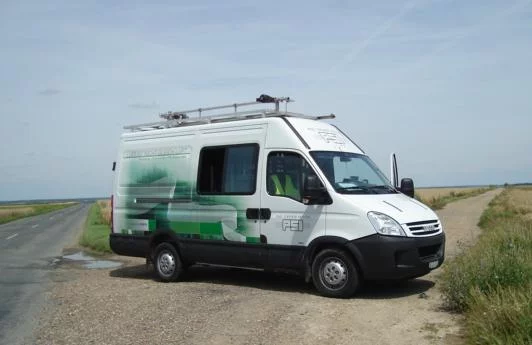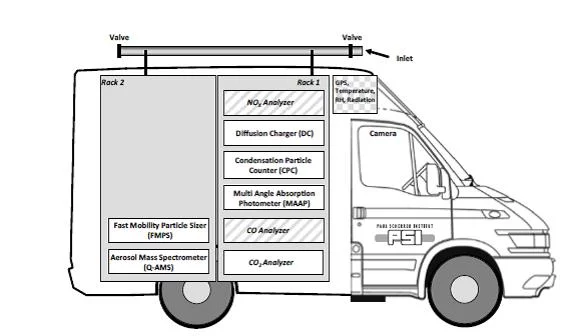Overview
The PSI mobile laboratory allows "Measurements Of Spatial Quantitative Imissions of Trace gases and Aerosols" (MOSQUITA) and a first version version was built in 2000 (Bukowiecki et al., 2001) and then modified by Weimer et al. (2009) and including aerosol mass spectrometry (Mohr et al., 2011). MOSQUITA is equipped with a suite of instruments to characterize the chemical composition and physical properties of aerosols as well as trace gases at high time resolution. The big advantage associated with this facility is the possibility to investigate both the spatial and temporal variability of the major aerosols parameters (e.g. chemical composition, particle number concentration, black carbon mass, etc.) and the identification of specific and very local sources.
Instruments
Several particle and gas phase instruments are deployed in this facility. Key instruments include the aerosol mass spectrometer, the multi angle absorption photometer (or Aethalometer) and the CO analyzer. In addition, the MOSQUITA is equipped with a Global Positioning System (GPS) to track the driving routes. The use of very high time resolution instruments is fundamental to characterize the dynamic behavior of the aerosols and their spatial variability.
| Measured parameter | Instrument |
|---|---|
| Particle chemical composition | Aerosol Mass Spectrometer (AMS); Aerodyne |
| Particle surface concentration | Diffusion Charging Particle Sensor Type LQ1-DC; Matter Engineering |
| Particle number concentration | 3010s CPC; TSI |
| CO2,H2O; IR-absorption | LICOR- 7000 (CO2); LICOR |
| Particle number size distribution | Fast Mobility Particle Sizer Spectrometer 309100; TSI |
| Black carbon mass concentration | MAAP 5012; Thermo |
| Black carbon mass concentration | Aethalometer, MAGEE Scientific AE33-ER |
| CO | CO Analyzer (Aerolaser) |
| NOx | NOx Analyzer (Scintrex) |
| GPS | Garmin IIplus |
| Temperature | thermilinear thermistor network YSI 44203 |
| Pressure | device constructed by PSI |
| RH | HUMICAP sensor, Vaisala HMP 31UT |
| Global radiation | pyranometer Kipp&Zonen “Solarimeter” CM10 |
Projects
- Mobile measurements in Switzerland including measurements in and around Zurich and in the Ticino
- Mobile measurements in Barcelona from February to March 2009 during the Daure project
- Mobile measurements in Paris in July 2009 and from January to February 2010 during the MEGAPOLI project
- Mobile measurements in the Po Basin, Italy, during the PEGASOS project in June 2012
- Mobile measurements in Estonia in March 2014
Sponsors
IVECO sponsored IVECO 35S14V Daily van including a special power supply for our application.
Publications
Journal Articles
A mobile pollutant laboratory - measuring gas phase and aerosol ambient concentrations with high spatial and temporal resolution.
Bukowiecki, N., J. Dommen, A. S. H. Prévôt, R. Richter, E. Weingartner, and U. Baltensperger, 2002
Atmospheric Environment, 36, 5569-5579.
Fine and ultrafine particles in the Zurich (Switzerland) area measured with a mobile laboratory. An assessment of the seasonal and regional variation throughout a year.
Bukowiecki, N., J. Dommen, A. S. H. Prévôt, E. Weingartner, and U. Baltensperger, 2003
Atmos. Chem. Phys., 3, 1477-1494.
Spatial variation of chemical composition and sources of submicron aerosol in Zurich during wintertime using mobile aerosol mass spectrometer data.
Mohr, C., R. Richter, P. F. DeCarlo, A. S. H. Prévôt, and U. Baltensperger, 2011
Atmospheric Chemistry and Physics, 11, 7465-7482.
DOI: 10.5194/acp-11-7465-2011
Mobile measurements of aerosol number and volume size distributions in an Alpine valley: Influence of traffic versus wood burning.
Weimer, S., C. Mohr, R. Richter, J. Keller, M. Mohr, A. S. H. Prévôt, and U. Baltensperger, 2009
Atmospheric Environment, 43, 624-630.



